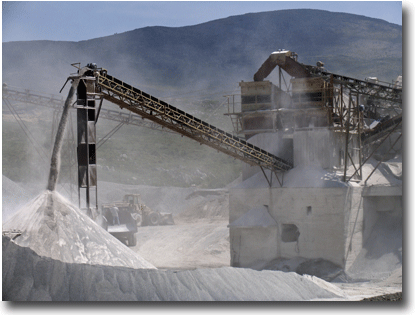Silicosis Lung Disease Information for Residents of New York
New York Workers Exposed to Silica Dust Face Risk of Silicosis Lung Disease, Lung Cancer, and TB

Silicosis is a serious lung disease caused by the inhalation of free silica particles. Silica is a component of almost every mineral deposit in the world, and can be found in a wide range of materials and products. Many different trades and occupations from mining to sandblasting to landscaping may result in silicosis. The condition may be acute, causing irreversible and even fatal lung damage soon after a high-level exposure, or it may be a chronic disease, progressive over time and difficult to detect, yet still deadly. Silicosis harms and kills workers in New York and throughout the country and the world each year, despite centuries of knowledge of the risks associated with silica exposure. The section contains information on silicosis risk factors, silicosis symptoms, and side effects. New York silicosis lawyers believe that persons who have a history of exposure to silica and have been diagnosed with lung disease may have grounds for a New York silicosis lawsuit. New York silicosis lawsuits provide meaningful compensation to persons and the families of persons in New York who have been harmed by this condition.
Silicosis Lung Disease
Silica: A Deadly Substance
Silica is a chemical compound, silicon dioxide, which is found throughout the earth’s crust in almost every mineral deposit. Silica is harmless until disturbed or maneuvered in a way that creates dust; persons working in industries that blast, drill, or grind materials containing silica are at risk of developing silicosis. Silica is most commonly found in quartz, which is the most ubiquitous mineral on the planet. Quartz can be found in soil, sand, concrete, masonry, rock, granite, and landscaping materials. Silica is also encountered in the minerals tridymite and cristobalite, which are found in rocks and soil. When these materials are cut, drilled, ground, or otherwise manipulated, crystalline silica particles are likely to become airborne. Breathing in silica dust can lead to severe and fatal illnesses including silicosis and lung cancer. Lung damage caused by silica dust exposure is irreversible and incurable. It is a progressive disease that worsens over time.

Understanding Silicosis
The respirable silica particles which cause silicosis are too small to be seen. Workers can be exposed to dangerous levels of silica dust without knowing it. Crystalline silica particles that become airborne during cutting, grinding, or other methods of processing may enter an unprotected worker’s airway. Crystalline silica particles travel through the respiratory system, into the lungs, and to the alveoli. The alveoli, which are small sacs in the upper nodes of the lungs, are the site of air exchange. Macrophages, or white blood cells, in the alveoli attack and ingest the silica particles. Lung cells and white blood cells are killed in this process, which creates inflammation in the lungs. The lung tissue has a protective reaction, creating fibrotic nodules to isolate the particles. When fibrosis, scar tissue and inflammation build in the lungs, the person will have increasing trouble breathing. Symptoms of silicosis start with difficulty breathing and progress to respiratory failure and even death.
- Early Silicosis Symptoms: dyspnea (shortness of breath) when exercising; fever; harsh, dry cough; cyanosis (bluish skin) at the ear lobes or lips
- Advanced Silicosis Symptoms: fatigue; trouble sleeping; hoarseness; extreme dyspnea (shortness of breath); loss of appetite; pains in chest; coughing up blood and difficulty breathing; respiratory failure and death
Types of Silicosis
The rate of progression of silicosis depends on the type of exposure. Exposure to a high level of crystalline silica dust produces an extreme reaction, while long term low-level exposure leads to silicosis that progresses slowly. The factors that most impact the type of silicosis a person develops include the concentration of silica particles in the dust and the amount of dust in the air. Researchers have identified three types:
| CHRONIC SILICOSIS | Occurs ten or more years after exposure at low concentrations, and can progress over time to cardiopulmonary arrest and respiratory failure. Chronic silicosis is the most common form of the disease, and may go undetected for years. |
| ACCELERATED SILICOSIS | Develops 5-10 years after the first exposure, and can progress over time to cardiopulmonary arrest and respiratory failure. |
| ACUTE SILICOSIS | Develops after exposure to high concentrations of silica dust, from five weeks to five years after exposure. Can cause cardiopulmonary arrest and respiratory failure. |
Silicosis Risk Factors
Any person who is exposed to respirable silica dust may develop silicosis. Factors that affect the degree of severity and rate of progression of the disease include:
- CONCENTRATION - the concentration of silica particles in the dust
- QUANTITY - the amount of dust in the air
- SIZE - the size of the silica particles
- SHAPE - whether the silica particles are crystalline or non-crystalline
- DURATION - the duration of exposure to the dust
- TIME LAPSE - the period of time from the first exposure to the development of symptoms and diagnosis (this number ranges from months to 30 years)
Silicosis, Lung Cancer, and Tuberculosis (TB)
Research has shown that silicosis increases a person’s risk for a variety of other health problems. The scarring and fibrous nodules that develop in the lungs make a person more susceptible to fungal and bacterial infections such as tuberculosis (TB). Crystalline silica particles are also believed to be a human carcinogen, meaning the presence of these particles in the lungs can cause lung cancer. Autoimmune disorders and chronic renal diseases have also been connected with silica dust inhalation.
New York Silicosis Lawyer Group Helps Workers and their Families

Our New York silicosis attorneys handling lawsuits on behalf of men and their family members in New York who have suffered from silicosis are offering free, no-obligation case reviews. Silicosis is a preventable condition, and companies who fail to protect their workers must be held accountable when a person is harmed or a life is lost as a result of silica exposure. Our New York silicosis lawyers are committed to the cause of justice and will work tirelessly on your behalf to assure you get the compensation you deserve. If you or a family member in New York developed lung disease following an isolated or prolonged silica dust exposure, or suffered from another condition such as lung cancer or tuberculosis, a New York silicosis attorney can help by answering your questions and giving you a sense of your legal options.
New York Silicosis Lawsuits
Persons who have developed lung disease or lung cancer from silica dust exposure may have grounds to file a New York silicosis lawsuit. Silicosis lawsuits in New York can provide meaningful compensation to New York individuals and families who have been harmed by silica exposure at work. Our attorneys offer expert legal representation for New York silicosis lawsuits on a contingency basis: our lawyers never charge any legal fees unless we win compensation on your behalf.

 OnderLaw, LLC -
OnderLaw, LLC -